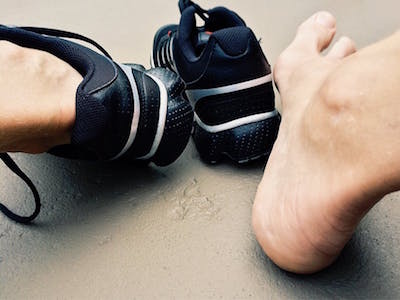In the realm of sports, athletes are revered for their strength, agility, and resilience. However, some athletes face an additional challenge that sets them apart—the presence of flat feet. Flat feet, or fallen arches, is a condition where the arches of the feet have collapsed or never fully developed. While it may seem like a disadvantage for athletes, this essay aims to explore the challenges faced by athletes with flat feet and highlight the triumphs they achieve through dedication, perseverance, and proper management of their condition.

I. Understanding Flat Feet:
To comprehend the impact of flat feet on athletes, it is crucial to understand the condition itself. Flat feet occur when the tendons and ligaments in the foot do not provide adequate support to maintain the arch, resulting in the sole of the foot coming into near-complete contact with the ground. This can lead to biomechanical issues, reduced shock absorption, and altered distribution of weight and forces during physical activities.
II. Challenges Faced by Athletes with Flat Feet:
- Reduced Shock Absorption: The arches of the feet act as natural shock absorbers, dissipating the impact of each step. For athletes with flat feet, the absence or minimal presence of arches can lead to increased stress on the feet, ankles, knees, and even the lower back, which can result in discomfort, pain, and potentially lead to injuries.
- Decreased Stability and Balance: Flat feet can compromise the stability and balance necessary for various sports activities. Without proper arch support, athletes may experience difficulties in maintaining balance, changing directions swiftly, and performing precise movements required in sports such as gymnastics, dance, and basketball.
- Pronation Issues: Overpronation, or excessive inward rolling of the foot, is a common issue among individuals with flat feet. Pronation is a natural movement that helps with shock absorption, but when it becomes excessive, it can strain the foot and leg muscles, leading to issues like shin splints, plantar fasciitis, and Achilles tendonitis.
III. Triumphs and Strategies for Athletes with Flat Feet:
- Proper Footwear: Choosing the right footwear is vital for athletes with flat feet. Specialized shoes with arch support, stability features, and cushioning can provide the necessary support and alleviate discomfort during physical activities. Custom orthotic inserts may also be prescribed to enhance arch support and align the foot properly.
- Strengthening Exercises: Athletes with flat feet can benefit from targeted exercises to strengthen the foot muscles and improve stability. Exercises such as toe curls, calf raises, and arch lifts can help build strength, enhance balance, and improve foot function.
- Physical Therapy: Engaging in physical therapy sessions can be immensely helpful for athletes with flat feet. Skilled therapists can provide tailored treatment plans that focus on improving flexibility, enhancing muscle strength, and addressing any imbalances or compensatory movements.
- Cross-Training and Injury Prevention: Athletes with flat feet can excel in sports by incorporating cross-training activities into their routines. Low-impact exercises like swimming, cycling, and rowing can provide cardiovascular benefits without placing excessive strain on the feet. Additionally, athletes should prioritize injury prevention techniques, such as proper warm-up routines, stretching, and using appropriate braces or taping methods to support the feet and ankles.
- Professional Guidance: Seeking guidance from healthcare professionals, such as podiatrists, orthopedists, or sports medicine specialists, is crucial for athletes with flat feet. These experts can provide individualized advice, diagnosis, and management strategies tailored to each athlete’s specific needs, ensuring their optimal performance while minimizing the risk of injuries.
While athletes with flat feet face certain challenges, their determination, adaptability, and implementation of strategies can lead to remarkable triumphs in the world of sports. Through proper management, athletes with flat feet can overcome the limitations imposed by their condition and achieve remarkable feats.
It is essential to highlight the success stories of athletes with flat feet who have overcome adversity. One such example is the legendary basketball player, Shaquille O’Neal. Despite having flat feet, Shaq dominated the basketball court throughout his career. He relied on specially designed footwear and orthotic inserts to provide the necessary support and stability for his feet. Shaq’s perseverance, combined with his exceptional skills and work ethic, allowed him to become one of the most dominant centers in basketball history.
Another inspiring example is the track and field athlete Jesse Owens, who had flat feet but went on to win four gold medals at the 1936 Olympics. Owens worked closely with his coaches and medical professionals to develop a training regimen that accounted for his foot condition. By focusing on strengthening exercises, wearing supportive footwear, and managing his training load effectively, Owens was able to showcase his incredible athletic abilities and overcome the challenges posed by flat feet.
These success stories highlight the importance of adopting a multifaceted approach when managing flat feet as an athlete. It involves a combination of proper footwear, strength training, flexibility exercises, and seeking expert guidance. By taking proactive steps to address the challenges posed by flat feet, athletes can unlock their full potential and achieve remarkable accomplishments.
Furthermore, it is essential to create awareness and understanding among coaches, trainers, and fellow athletes about the unique needs and challenges faced by athletes with flat feet. By promoting a supportive and inclusive environment, athletes can receive the necessary encouragement and resources to thrive in their respective sports.
In conclusion, athletes with flat feet encounter specific challenges due to the biomechanical nature of their condition. However, with the right strategies, determination, and support, they can triumph over adversity and excel in their chosen sports. It is crucial to emphasize the significance of proper footwear, strength training, physical therapy, and seeking professional guidance for optimal management. Athletes with flat feet should be celebrated for their resilience and achievements, as they exemplify the indomitable spirit of human potential.
